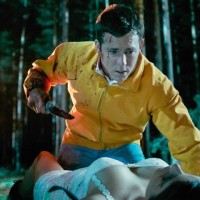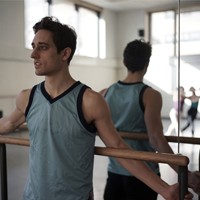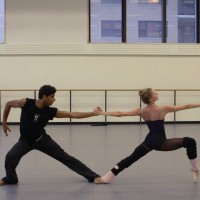An Insane Ryan Reynolds, An Inspired Justin Peck
One great thing about living in NYC is the wide range of new movies to pick from. These two have just opened in theaters: serial killer horror/comedy or backstage ballet documentary? Your choice…
The Voices
Whatever one might have expected from director Marjane Satrapi after the acclaimed adaption of her autobiographical graphic novel Persepolis (2007) and the poignant, surreal fable Chicken with Plums (2011), The Voices is not it. (Unlike those earlier films, she had no hand in writing this movie; that honor goes to Michael R. Perry, known mainly for TV work.) A queasy crime thriller disguised as an office romcom, The Voices stars the usually inoffensive Ryan Reynolds as a very disturbed man. Melding the blackest imaginable humor, scenes of bloody horror and some impressively solid acting — Reynolds hasn’t had a role this challenging since 2010’s Buried — Satrapi has created something quite unique. While not exactly a masterpiece of filmmaking, The Voices is twisted, harrowing and funny, the latter mainly due to a pair of talking animals.
Reynolds plays Jerry, a seemingly upbeat, nice-guy shlub with a dark past, who works for a bathroom fixture company that also employs luscious Fiona (Gemma Arterton) and down-to-earth Lisa (Anna Kendrick). Sharing his home are dog Bosco and cat Mr. Whiskers, who give Jerry advice when he’s off his meds, which is often. Bosco’s a lovingly supportive type, while Whiskers is a taunting, foul-mouthed provocateur — talk about animal stereotyping — with a Scottish accent (both are voiced by Reynolds). In the grand tradition of animal characters, they steal the show. Though Jerry sees a psychiatrist (the always excellent Jacki Weaver), he lies to her about hearing voices and his condition in general until things get completely out of hand.
After a car accident involving his crush Fiona (and a talking deer), Jerry slides further into madness, committing a horrifically bloody murder followed by body disposal involving many Tupperware containers. Goaded by his cat and a disembodied head in his fridge, he continues down this slippery slope, questioning and fighting his awful impulses, leading to an explosive culmination. Well, the movie’s actual ending involves a song and dance number involving Jesus, but that’s really a coda.
Reynolds, his close-set puppy-dog eyes registering determination, remorse and fear, is perfect as a badly-damaged psychotic. He’s both frightening and sympathetic as he struggles to to reason out his deranged thought processes. The film’s bright cartoonish colors and abrupt shifts in tone (flashbacks to Jerry’s childhood are uniformly wrenching) keep the viewer off-balance and uneasy. This is far from a lightweight romp. While obviously not for everyone, The Voices has its perverse charms.
Ballet 422
For those fascinated by the impossible artform that is ballet, Jody Lee Lipes’ new documentary Ballet 422 is a must-see. But even those unfamiliar with that insular, idiosyncratic world can appreciate this behind-the-scenes look at the making of New York City Ballet’s 422nd production (Paz de la Jolla) by a rising young choreographer. Justin Peck was just 25 and a member of New York City Ballet’s corps (essentially a chorus dancer) when he was tapped to create a new work for the company’s 2013 winter season in a mere two months. Having created a couple of previous ballets for NYCB, he wasn’t a complete neophyte, but still relatively new to the painstaking process.
In Ballet 422, we see the soft-spoken but firm Peck working out his fast, spirally movements on the piece’s principal dancers Tiler Peck (no relation), Sterling Hyltin and Amar Ramasar, all of whom contribute to a process that is clearly collaborative. We also witness him dealing with costume and lighting designers, conductor and orchestra, in addition to the minutiae of any dance performance. There are quiet scenes of him alone, concentrating intensely on the playback of a particular rehearsal sequence or patiently waiting for the subway. Though he sometimes appears tired, his focus is unwavering and he remains unfailingly polite and unruffled.
Lipes forsakes interviews, voice-overs and other explanatory devices for a stark cinéma vérité style. There’s no built-up will-he-pull-it-off drama, just unobtrusive, no-frills camerawork, refreshing in its simplicity. By the time we see snippets of the ballet’s premiere — from various vantage points including the wings and overhead — we understand what an accomplishment it is. We also recognize Peck’s obvious talent; Paz de la Jolla is an inventive, energetic ballet that shows off his unique style (and the company’s dancers) nicely. A startling juxtaposition occurs at the film’s end, when Peck transforms from celebrated choreographer back to corps dancer. (It’s not quite as drastic as Cinderella after the ball, but the analogy comes to mind.)
He has since been promoted to soloist and resident choreographer at City Ballet, with several more works under his belt, including this week’s premiere of ‘Rōdē,ō: Four Dance Episodes, to the iconic score by Aaron Copland. Ballet 422 captures a time not long ago when he was still proving himself; it’s a perceptive look at a crucial phase in a young artist’s career.
The Voices is playing at AMC Empire 25, 234 West 42nd Street, Manhattan.
Ballet 422 is playing at Landmark Sunshine Cinema, 143 East Houston Street; and Elinor Bunin Munroe Film Center, 144 West 65th Street, Manhattan.
—Marina Zogbi





